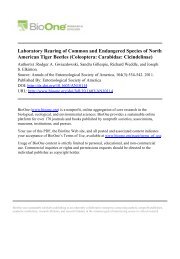Building Models from Experimental Data. - elkintonlab
Building Models from Experimental Data. - elkintonlab
Building Models from Experimental Data. - elkintonlab
Create successful ePaper yourself
Turn your PDF publications into a flip-book with our unique Google optimized e-Paper software.
Pathogen-Driven Outbreaks Revisited 115<br />
density gypsy moth populations are strongly correlated<br />
with changes in densities of white-footed mice (Elkinton<br />
et al. 1996; Ostfeld et al. 1996), and experimental removals<br />
of small mammals lead to sharp increases in gypsy moth<br />
populations (Jones et al. 1998). The major food of whitefooted<br />
mice, however, is acorns. Consequently, changes in<br />
mouse population densities are strongly correlated with<br />
changes in the acorn crop (Elkinton et al. 1996; Ostfeld<br />
et al. 1996), and experimental additions of acorns can<br />
prevent increases in gypsy moth populations (Jones et al.<br />
1997). Because the acorn crop depends in turn on regional<br />
weather patterns, the strongest overall effect of smallmammal<br />
predation on gypsy moth population dynamics<br />
may be that it introduces variability in gypsy moth net<br />
fecundity at low density. In particular, several successive<br />
years of poor acorn crops lead to collapses in small mammal<br />
populations that allow gypsy moth populations to<br />
grow to densities at which small-mammal predation is<br />
insignificant. Such populations eventually reach the high<br />
densities at which virus epidemics occur. This variability<br />
may explain some of the fluctuations seen in time series<br />
of gypsy moth defoliation data (Williams and Liebhold<br />
1995) and may affect the periodicity and stability of the<br />
fluctuations in our models. An important future direction<br />
for modeling gypsy moth population dynamics is thus to<br />
include small-mammal predation and environmental stochasticity.<br />
Likewise, quantitative application of our models<br />
to the dynamics of other forest insects may require other<br />
biological details. Western tent caterpillars, for example,<br />
experience reduced fecundity due to the exposure of larvae<br />
to low doses of virus (Rothman and Myers 1994), an effect<br />
that does not occur in gypsy moths (Murray et al. 1991).<br />
We therefore echo calls for models that investigate multiple<br />
factors in insect population dynamics (Bowers et al. 1993;<br />
Hunter and Dwyer 1998).<br />
It is important to emphasize, however, that the dynamics<br />
of the gypsy moth and other outbreaking insects may be<br />
less complicated than is sometimes believed. For example,<br />
recent data suggest that maternal effects (Myers et al. 1999;<br />
M. Erelli, personal communication) and induced hostplant<br />
defenses (D’Amico et al. 1998) may have little effect<br />
on gypsy moth population dynamics. A major point of<br />
our work is thus to illustrate the usefulness of simple models.<br />
Indeed, the infinite-epidemic model tells us much of<br />
what we need to know about the short-epidemic model,<br />
yet the former can be analyzed mathematically and so<br />
understood more deeply than the latter, which can only<br />
be simulated. In fact, our infinite-epidemic model was<br />
inspired by May’s (1981) model, which makes the additional<br />
assumption that the yearly epidemic is begun by an<br />
infinitesimally small density of pathogens. Simple models<br />
can thus be at least as useful as giant simulation models<br />
in understanding host-pathogen dynamics (Onstad et al.<br />
1990) and have the advantage of being more easily<br />
understood.<br />
Acknowledgments<br />
We thank C. H. J. Godfray, E. Holmes, W. F. Morris, A.<br />
F. Hunter, and K. L. S. Drury for commenting on earlier<br />
versions of the mansucript. Our research was supported<br />
by National Science Foundation (NSF) grant DEB-97-<br />
07610 to S.A.L. and G.D., who was also supported by a<br />
Dropkin Fellowship awarded by the University of Chicago<br />
and two earlier NSF grants awarded to G.D. and J.S.E.<br />
G.D. thanks J. M. Bergelson and the NSF for shelter <strong>from</strong><br />
the storm, C. Styles for navigational assistance during the<br />
storm, and A. F. Hunter for a reason to endure the storm.<br />
APPENDIX A<br />
Derivation of the Infinite-Epidemic Equation<br />
In this appendix, we derive equations (4) and (5), which<br />
give the initial conditions at the start of the epidemic, and<br />
we derive the infinite-epidemic equation (8) (of which eq.<br />
[3] is a special case).<br />
The Egg-Mass Infection Process<br />
As we discuss in the main text, our assumption is that the<br />
process by which hatching larvae become infected is essentially<br />
identical to the process by which larvae become<br />
infected later in the season. We therefore model it using<br />
the equations<br />
S = hnSZ t ,<br />
(A1)<br />
t<br />
<br />
dP = hZ t nS(n, t)dn, (A2)<br />
dt 0<br />
where h is the susceptibility of hatching larvae relative to<br />
the susceptibility of larvae later in the season. For simplicity,<br />
here we assume that overwintering pathogens can<br />
infect egg masses for some fixed period of time, say, of<br />
length ˆt . Integrating equations (A1) and (A2) <strong>from</strong> 0 to<br />
ˆt gives equations (4) and (5) in the main text, with the<br />
definition r { ht ˆ. Allowing for alternative assumptions<br />
about the length of time for which egg masses are exposed<br />
and the pathogen is infectious is not difficult; a constant<br />
rate of breakdown v of the pathogen, for example, gives<br />
vt ˆ<br />
r { h(1 e ). Because we do not expect to be able to<br />
distinguish among these processes, in the main text we<br />
introduce only the aggregate parameter r that allows for



